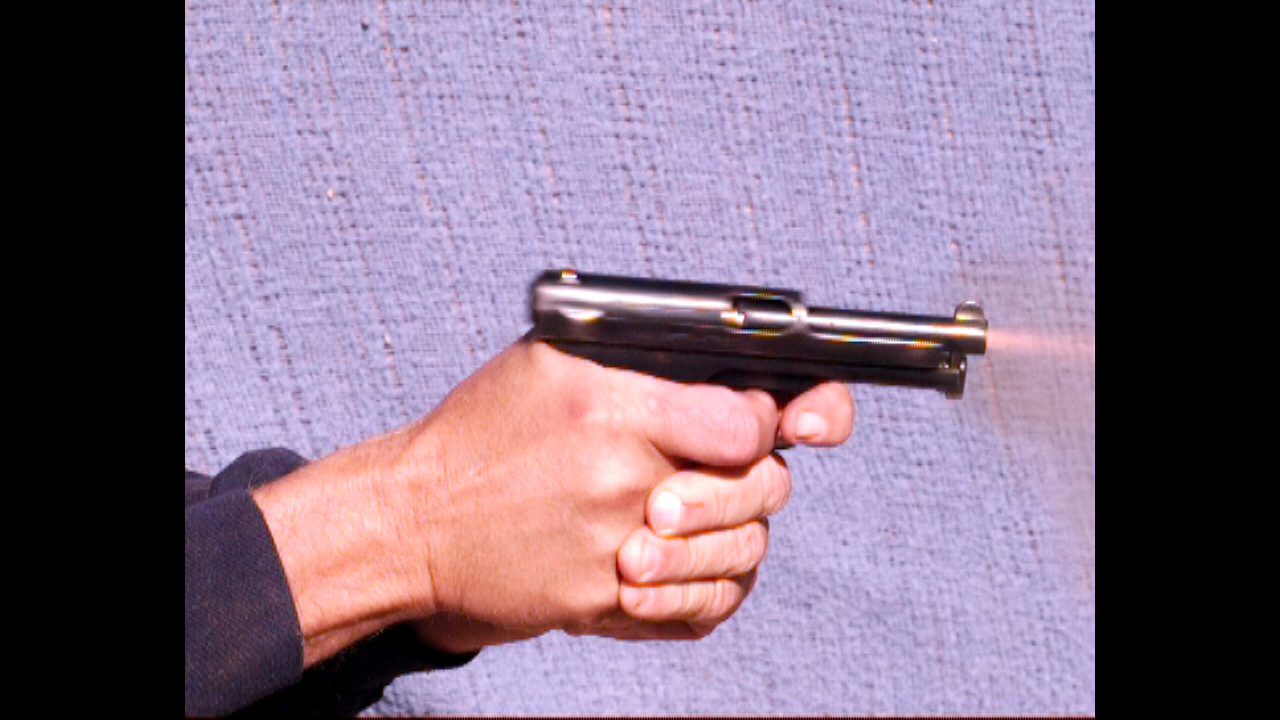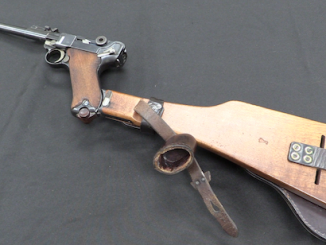With the advent of successful self-loading pistols, one of the additional markets that many companies tried to appeal to was the compact carbine. Self-loading rifles in proper rifle cartridges would not be developed as quickly as the pistols because their much greater chamber pressures represented a more difficult engineering problem. However by simply attaching a stock and long barrel to a pistol, many ambitious manufacturers hoped to sell a weapon as a sporting carbine. These were done by DWM with the Luger, as well as Mauser’s C96, Mannlicher 1894 pistol, and many others.
Model 1902 was the designation of the major batch of commercially made Luger carbines, although there were several small batches of prototypes prior. Only a couple thousand were made, and they ultimately took quite a long time to all sell – it turned out this type of firearm was simply not very popular for its cost. The same story was true with the other contemporary pistol-carbines – none would be very successful. DWM did make another group of carbines in the 1920s, although those were made from various leftover parts and are both not as nice as the original 1902 guns (which were mostly made in 1904 and 1905) and widely faked.




with the scaloped toggle grips and the anti rebound catch on the toggles, that gun almost certainly had the leaf recoil spring.
At least some had a second coil spring concealed in the forearm, on a guide rod attached to the front of the frame and bearing on a “ring” forged on to the underside of the barrel. This was mainly to help haul the action back into battery against the extra mass of that long and fairly heavy “schnozzola”. The OM leaf recoil spring wasn’t quite enough to get the job done every time.
cheers
eon
even with a 4″ barrel, it doesn’t take much dirt to slow the action and for the toggle to fail to go fully down into battery.
there is a slight clearance with either type of recoil spring to allow field stripping, but that results in less than positive closing of the toggle.
I seem to recall reading decades ago that Kaiser Welheim had a withered arm (due to polio, I think) and used one of these as a hunting rifle because he couldn’t support a full-size rifle. Beautiful weapon, but I doubt in the real world if it would be much of an improvement over an 8″ artillery Luger with the detachable stock.
“Kaiser Welheim”
Sorry but i can’t stop myself: WILHELM or WILHELM DER ZWEITE (as emperor of Germany) or FRIEDRIECH WILHELM VIKTOR ALBERT VON PREUßEN (full name) but not WELHEIM
No. The last Kaiser had brachial plexus stretch injury from birth trauma.
In France the luger carabine is considered an antique so anyone can buy one
If you are rich
“antique”
What conditions fire-arms must full-fill to be considered antique according to law of France?
Another question is what kind of legal history did the gun have up until it was old enough to be classified as an antique? Because presumably, in the intervening years, a gun (and its owner) would have had to be registered, licensed, taxed, and all the rest.
It would seem like an incentive for someone to illegally possess a [restricted] gun for many decades, until it finally became legal to own due to its age and rarity exempting it from gun laws — at which point it could then be sold for a lot of money.
What you suggest might be true in some countries, but probably not in France due to the changes to firearms laws after WW2. France used to have many completely free gun types prior to 1995, which didn’t require a license or permit and could be sold “over the counter”. They still have some, although not nearly as many. This is in contrast to for example (West) Germany and the Nordic countries, where legal purchase and ownership of all metallic cartridge firearms have required either registration or increasingly an official license at least from the 1950s onward.
Black powder guns with no metallic cartridges and weapons designed prior to 1880? The Luger Carbine belongs to neither, so there must be some guns which are considered antique on individual basis, similar to the US “curio & relic” category.
“individual basis”
Then question is: who decides which weapons is or is not antique?
That’s a very good question. In the USA, an antique firearm is fairly well defined by federal law (though ambiguities certainly exist; I’m still not sure about how laws that only specifically mention centerfire and rimfire would legally classify pinfire). In contrast, a “C&R” can apparently be anything that someone wants it to be, including modern military-issue weapons such as the SVD Dragunov.
It’s the same way with the “sporting purpose” exemption that allows some large-caliber guns but not others. (How the massive .950 JDJ could possibly be considered “sporting” is another unsolved mystery — dinosaur hunting, perhaps?)
The classification, as applied, is so inconsistent and contradictory that it would not surprise me if manufacturers and importers were slipping ATF officials bribes of some kind in order to get their otherwise-restricted guns awarded C&R or “sporting purpose” status.
““sporting purpose””
Which give also different loophole: 12 gauge is legal? is! but this only gives bore diameter, not case length – thus it is possible to do LONGER version which still is 12 gauge (which is legal). So: meet the 12 GAUGE FROM HELL, see photos here:
http://www.us-shooter.com/700-nitro-express-power-from-a-12-gauge-shotgun/
which is basically 12 gauge/3.5″ – launch 1100 gr @ 2400 fps
(different gauges crafted in such way also exist, for example: 20 GAUGE FROM HELL and 28 GAUGE FROM HELL)
“However by simply attaching a stock and long barrel to a pistol, many ambitious manufacturers hoped to sell a weapon as a sporting carbine. These were done by DWM with the Luger, as well as Mauser’s C96, Mannlicher 1894 pistol, and many others.”
Any photo of said Mannlicher 1894 with stock and/or longer barrel? I know that Mannlicher 1894 was blow-forward produced in very small quantity.
I think he was talking about the 1901 Mannlicher pistol. As it were, the 1894 model would have made a terrible carbine as the barrel mass would necessitate a much stronger recoil spring and the trigger’s function as the hold-open device would certainly invite lots of accidental discharges… Or am I wrong?
“1901 Mannlicher”
This weapon: http://www.hungariae.com/Mann01.htm ?
I never see stocked / longer-barrel version, so I still waiting for photos.
Oops. Just found out I was wrong, it was supposed to be the 1896 pistol which got the carbine variant. We saw that last year.
I would guess that few of these guns in the US today have the original stocks, as most early owners presumably would have gotten rid of the stock in 1934, rather than pay a $200 tax on a $50 gun (or risk going to prison for 10 years). If these were still being sold as new up until the National Firearms Act effectively outlawed all SBRs, it must have been a long uphill climb for anyone to get these re-classified as antique/curio-relic in the eyes of the ATF.
That’s assuming that getting rid of the stock would have in itself made it a non-NFA gun, since the ATF (at least today) requires that a pistol must be strictly one-handed and thus cannot legally have a grip for the second hand.
I do not know about the commercial pistol stocks, but the shoulder stocks as for the C96s and artillery Lugers were kept separate from the firearm in the armory. It is quite rare to have a matching military stock serial number to the weapon.
A pistol can have a horizontal handguard but not a vertical grip. The Thompson-Center Contender is one example. Also, every AR and AK pistol has a handguard.
True, that seems to have been the AFT’s rule in recent times that an AR pistol can have a horizontal grip parallel to the barrel but not a vertical one projecting below the barrel (a 45 degree add-on handgrip is apparently also allowed, though most other orientations, such as a horizontal grip perpendicular to the barrel, etc, have apparently never been defined) even though that legal restriction is nowhere to be found in any actual law, but is entirely derived by the ATF from the legal definition of a handgun as being fired by (only) one hand.
Whether or not this “some off-hand pistol grips are more equal than others” rule has been consistent since 1934 or has evolved and/or flip-flopped over the years, I don’t know. It would seem logical that if some types of handholds are banned according to the “one-handed” legal definition of a handgun, then all should be banned. It would also seem logical that according to the ATF’s previous ruling that since the act of shouldering a pistol with a wrist support automatically turns the pistol into a non-pistol (SBR), then firing a pistol with a normal two-handed grip would also turn the pistol into a non-pistol (AOW). But consistency applied rules is not one of the ATF’s principles.
Lot of german stuff in this new auction, huh?
Are you not impressed? Many “surplus” guns old enough to be interesting seem to be German. Most of the others seem to have been sold, lost, or worse, destroyed by stupid anti-gun bureaucrats who can’t tell the difference between a modern AR-15 and a vintage StG-44.
“german stuff”
Remember: Germany lost 2 world wars, in all fighting in many, many places so there was many, many occasions where German equipment might be captured.
France has a curio and relic list as in the us and several progun organizations such as the UFA which fights for primarily collectors rights
They routinly propose non antique guns such as the luger and mauser carabines webley foresberry(spelling)be taken off the list of guns needing a permit
In france you can find guns in your attic or barn which can then be licenced or neutrilized
Last year when military bolt actions were able to be FINALLY bought with a simple hunting licence somebody FOUND 41